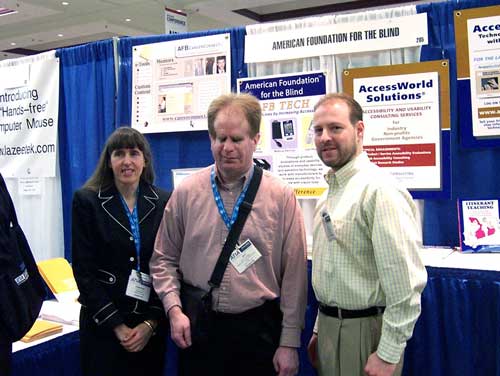The seventh annual conference of the Assistive Technology Industry Association (ATIA) was held on January 18-21, 2006, at the Caribe Royale hotel in Orlando, Florida. More than 1,500 people attended, and more than 120 exhibitors showed products for people with a range of disabilities.
This conference offered better access for people who are blind than did previous conferences. The hotel staff were well trained and helpful, and braille menus were available in hotel restaurants. Red carpeting was again used to assist people in navigating among the hotel towers and the convention center where the events were held.
However, as did previous conferences, this one had some access problems. The people who worked at the conference registration were not trained in how to communicate with people who are blind. They also did not know what was on the CDs that were handed out with the registration packets. In addition, the covers of the volumes of the braille conference program contained only raised print. This format was convenient for sighted people, but meant that braille readers had to open the volumes to find out what each one contained. It would have been much better to have both braille and print on the covers.
Caption: The American Foundation for the Blind booth at ATIA. From left: Crista Earl, Jay Leventhal, Lee Huffman.
Conference Sessions of Interest
ATIA featured sessions that appealed to people of various levels of expertise, including sessions introducing new products and updates to products, sessions on different ways to use products in the classroom and elsewhere, and sessions reporting the results of research studies. There were a number of sessions on the National Instructional Materials Accessibility Standard (NIMAS), which guides the production and electronic distribution of digital versions of textbooks and other instructional materials so they can be more easily converted into accessible formats. These presentations were made by representatives of publishers and educational agencies, teachers, and assistive technology developers. The aim is to get accessible textbooks into the hands of students in a timely manner.
Numerous manufacturers demonstrated the latest updates to their products. For example, Cathy Gettel, of Ai Squared, demonstrated the new features of ZoomText 9.0; how to access the Internet, e-mail and other applications; and how users can increase their speed and accuracy in computing tasks.
Nancilu McClellan, of Metroplex Voice Computing, demonstrated MathTalk, which allows users to dictate math problems into a computer with speech feedback. The user can then speak a command that will save the file, open Duxbury, open the file in Duxbury, and translate it into braille. It does best with linear math but does not do column math well. As it is developed further, it should prove to be a useful tool for users who want to create print and braille math problems or worksheets.
Jonathan Lazar, of Towson University, presented research on the problems that users of screen readers experience. In his study, 100 users of screen readers browsed the web for two hours and reported on the problems they encountered. The most common problems that they noted were (1) confusing feedback from the screen reader caused by the page layout (36); (2) no or misleading alt text for pictures (33); (3) conflict between the screen reader and the application (28); (4) poorly labeled or unlabeled forms (23); and (5) screen reader crashes, inaccessible PDF files, and misleading labels for links (each had 15).
The findings were compared with those for 200 sighted people who took the same test. The results showed that the screen-reader users were much less likely to reboot the computer or restart the program and were much more likely to find alternative solutions than were the sighted users. The conclusion was that blind users waste less time and are more effective in responding to the problems they encounter with computers.
New Products
Freedom Scientific introduced a new line of CCTVs called TOPAZ. The TOPAZ magnifies from 2x to 70x on a 19-inch monitor. There are five models: 17-inch and 19-inch LCD (liquid crystal display) models with slim, nonglare screens; 15-inch and 17-inch CRT monitor models; and a camera-only model. The viewing modes include full color, black on white, enhanced black on white, inverted white on black, yellow text on blue, and blue text on yellow. The prices range from $1,995 to $2,995.
Optelec launched the EasyLink 12, a wireless braille keyboard with a 12-cell refreshable braille display that is designed to give persons who are blind wireless access to their PCs, PDAs (personal digital assistants), and smart phones. EasyLink 12 is compatible with desktop and pocket screen readers. It measures 5.9 inches long by 3.8 inches wide by 0.8 inches thick.
Pocket Hal, from Dolphin Computer Access, and Mobile Speak Pocket, from Code Factory of Spain, are two new screen readers for pocket PCs. Both products can run on a variety of off-the-shelf pocket PCs and provide access to numerous applications.
Bookshare.org now offers its members New York Times top-10 best-sellers in fiction and nonfiction (both hardcover and paperback.) The Bookshare collection now includes over 26,000 books.
HumanWare released version 7.0 of the KeySoft software for its BrailleNote family of PDAs. KeyBase is a new database manager that permits the easy creation of your own databases. KeyBase ships with many useful databases already created. Other new additions include interactive fiction games, braille input for JAWS for Windows, Bluetooth synthesizer and braille display connections with your computer, and Eloquence speech and FM radio for the BrailleNote and VoiceNote mPower.
This is just a sampling of the knowledge and networking opportunities that were shared by the participants at the conference. The ATIA conference continues to grow and has become an important yearly event in the field of assistive technology.
